北师大版高一年级下册英语课件必修二 Unit 6 The Admirable (5)(共56张PPT)
文档属性
| 名称 | 北师大版高一年级下册英语课件必修二 Unit 6 The Admirable (5)(共56张PPT) | 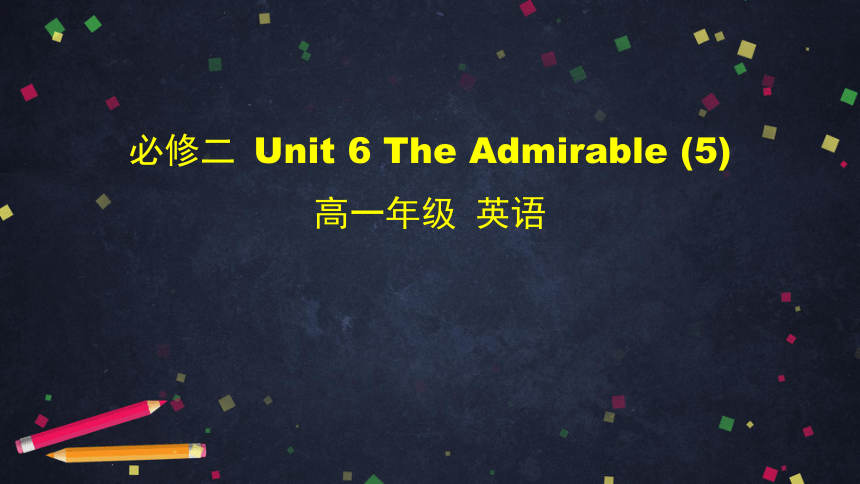 | |
| 格式 | zip | ||
| 文件大小 | 19.7MB | ||
| 资源类型 | 教案 | ||
| 版本资源 | 北师大版(2019) | ||
| 科目 | 英语 | ||
| 更新时间 | 2020-05-19 22:35:43 | ||
图片预览




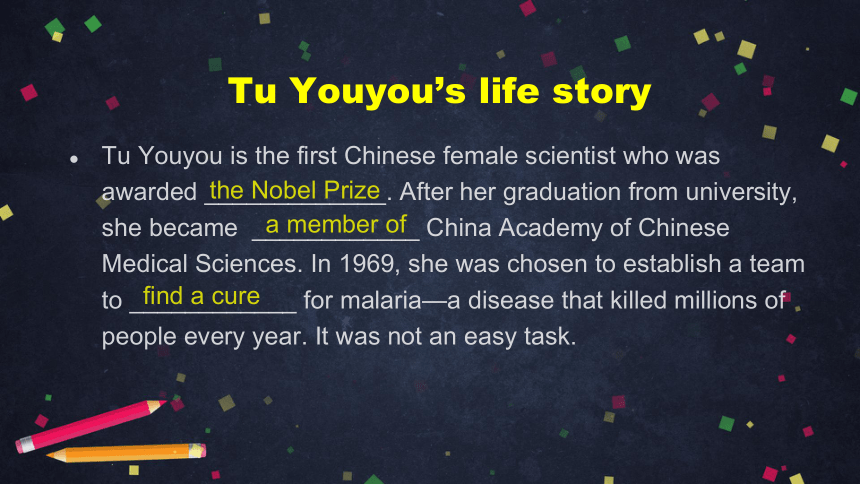
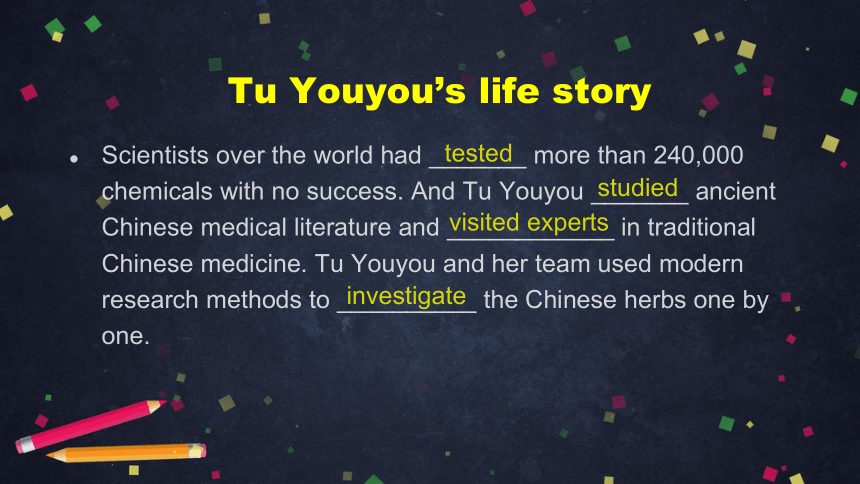


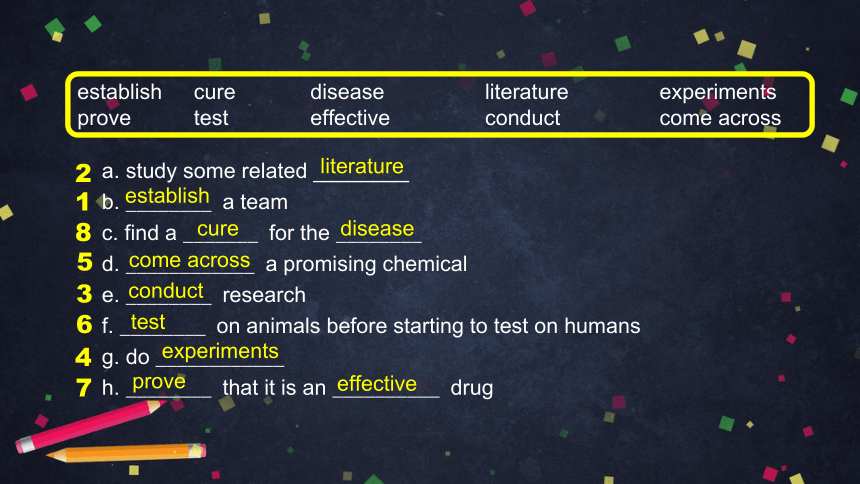
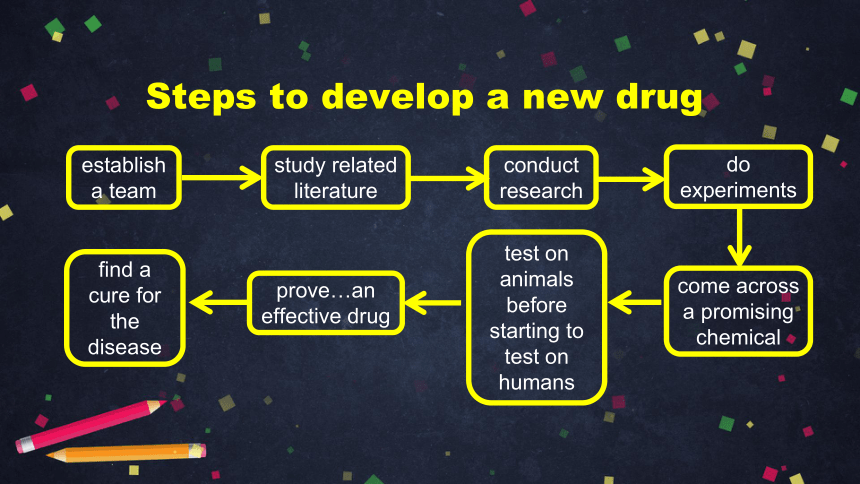
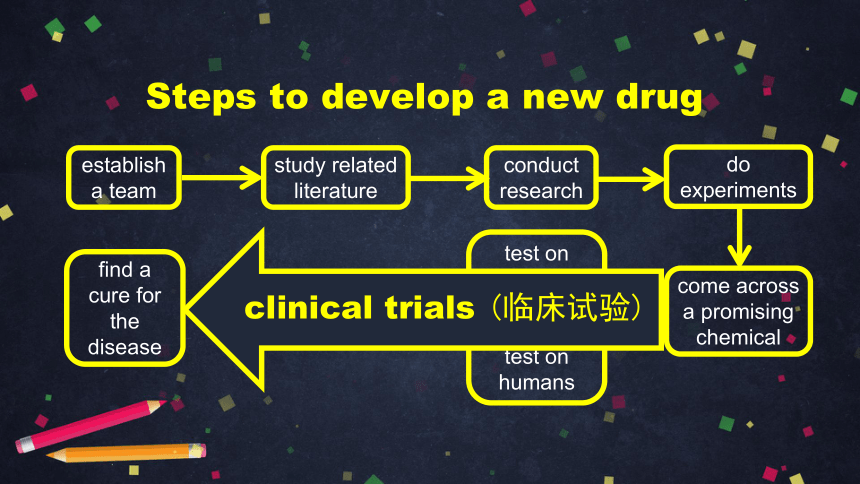

文档简介
(共56张PPT)
必修二 Unit 6 The Admirable (5)
高一年级 英语
Lesson 1 A Medical Pioneer (2)
Reading
How much do you remember ?
born in Zhejiang in 1930;
studied medicine at Peking University Health Science
Center;
studied Chinese medicine with experts in the field;
How much do you remember ?
was given the task to find a cure for malaria;
turned to Chinese herbs for help when worldwide
scientists failed to find a cure using modern chemicals;
found a possible chemical after hundreds of failed
experiments;
volunteered to test on their own bodies;
finally discovered the most effective drug;
not interested in fame and prefers to continue her research.
Tu Youyou’s life story
Tu Youyou is the first Chinese female scientist who was awarded _____________. After her graduation from university, she became ____________ China Academy of Chinese Medical Sciences. In 1969, she was chosen to establish a team to ____________ for malaria—a disease that killed millions of people every year. It was not an easy task.
the Nobel Prize
a member of
find a cure
Tu Youyou’s life story
Scientists over the world had _______ more than 240,000 chemicals with no success. And Tu Youyou _______ ancient Chinese medical literature and ____________ in traditional Chinese medicine. Tu Youyou and her team used modern research methods to __________ the Chinese herbs one by one.
tested
studied
visited experts
investigate
Tu Youyou’s life story
After hundreds of _______________, they eventually came across a promising chemical. The medicine they discovered was artemisinin, which has now become the world’s most ____________ for fighting malaria.
failed experiments
effective drug
Complete the steps with the words and phrases below. Then put them in order.
How is a new drug developed?
a. study some related ________
b. ________ a team
c. find a _______ for the ________
d. ____________ a promising chemical
e. ________ research
f. ________ on animals before starting to test on humans
g. do ____________
h. ________ that it is an __________ drug
establish cure disease literature experiments
prove test effective conduct come across
literature
conduct
cure
disease
come across
establish
test
experiments
prove
effective
1
2
3
4
5
6
7
8
Steps to develop a new drug
establish a team
study related literature
conduct research
do experiments
come across
a promising chemical
test on animals before starting to test on humans
prove…an effective drug
find a cure for the disease
Steps to develop a new drug
establish a team
study related literature
conduct research
do experiments
come across
a promising chemical
test on animals before starting to test on humans
prove…an effective drug
find a cure for the disease
clinical trials (临床试验)
This was not an easy task. The reason why this was difficult was that the team had limited resources. They did not have enough staff, and the laboratory in which they worked had poor air quality.
Read the paragraph and answer the following questions.
What difficulties did they meet during the clinical trials?
How did they deal with the difficulties?
What sacrifice did they make?
However, obtaining effective samples was only the first step, and clinical trials had to be carried out before massive application could be implemented (实施), which required a large amount of artemisinin. At that time, no pharmaceutical factory (制药厂) could provide that amount. The challenges tested the state’s patience as tens of thousands of people were infected with malaria.?
Under these circumstances, Tu and her team continued to overcome the increasing pressure and discover new ways to conduct their research?. They moved seven water vats to the laboratory for experiments. The containers were filled with ether and the artemisia apiacea (青蒿) was immersed in them to extract (提取) test samples.
household water vats
ether (乙醚)
As we know, ether is a harmful chemical. During that period of time, the strong smell of ether spread all over the laboratories. Working in such an environment was dangerous and Tu and her team made huge sacrifices. ?
In addition to dizziness, they experienced such symptoms as nose bleeds and skin allergies. Tu Youyou was ultimately diagnosed with toxic hepatitis (中毒性肝炎). Other research members also suffered. Zhong Yurong had to remove parts of?the lungs, and Cui Shulian lost her life during the research. ?Even before her death, she did not complain or have any regrets.
?
dizziness
skin allergies
Q1: What difficulties did they meet during the clinical trials?
However, obtaining effective samples was only the first step, and clinical trials had to be carried out before massive application could be implemented, which required a large amount of artemisinin. At that time, no pharmaceutical factory (制药厂) could provide that amount. The challenges tested the state’s patience as tens of thousands of people were infected with malaria.?
To carry out clinical trials, they need a large amount of artemisinin, but at that time no pharmaceutical factory could provide that amount.
What difficulties did they meet during the clinical trials?
Q2: How did they deal with the difficulties?
How did they deal with the difficulties?
Under these circumstances, Tu and her team continued to overcome the increasing pressure and discover new ways to conduct their research?. They moved seven water tanks to the laboratory for experiments. The containers were filled with ether and the artemisia apiacea (青蒿) was immersed in them to extract test samples.
They tried to discover new ways to conduct their research. They moved seven water tanks to the laboratory. They filled the tanks with ether and immersed the artemisia apiacea in them to extract test samples.
Q3: What sacrifice did they make?
As we know, ether is a harmful chemical. During that period of time, the strong smell of ether spread all over the laboratories. Working in such an environment was dangerous and Tu and her team made huge sacrifices. In addition to dizziness, they experienced such symptoms as nose bleeds and skin allergies. Tu Youyou was ultimately diagnosed with toxic hepatitis (中毒性肝炎). Other research members also suffered. Zhong Yurong had to remove parts of?the lungs, and Cui Shulian lost her life during experimentation. ?Even before her death, she did not complain or have any regrets.
What sacrifice did they make?
They suffered from dizziness, nose bleeds and skin allergies. Tu Youyou even was diagnosed with toxic hepatitis. Zhong Yurong had to remove parts of?the lungs, and Cui Shulian lost her life.
What sacrifice did they make?
Read the article again and try to find evidence to support your opinion.
What lead to their success?
She studied medicine at Peking University Health Science Centre. After graduation, she became a member of China Academy of Chinese Medical Sciences. Later, she studied Chinese medicine for two and a half years with experts in the field from whom she gained a deep knowledge about traditional practices.
Traditional Practices
acupuncture
Four Diagnostic Methods
tuina
Education Background
She studied medicine at Peking University Health Science Centre. After graduation, she became a member of China Academy of Chinese Medical Sciences. Later, she studied Chinese medicine for two and a half years with experts in the field from whom she gained a deep knowledge about traditional practices.
“Fortune favors the prepared mind” and “what’s past is prologue (序曲).” My prologue of integrated training in both modern and Chinese medicine prepared me for the challenges when the opportunities to search for antimalarial Chinese medicines became available.
—Tu Youyou
Patience & Devotion
They tested more than 240,000 chemicals with no success.
She researched hundreds of traditional recipes connected to anti-malarial cures.
Then Tu Youyou and her team began using modern research methods to study these Chinese herbs one by one.
Chinese herbs
Traditional recipes
“After accepting the task, I collected over 2000 herbal, animal and mineral prescriptions…, interviewing well-known and experienced Chinese medical doctors… I summarized 640 prescriptions… It was this information collection and deciphering (解析) that laid a sound foundation for the discovery of artemisinin.”
—Tu Youyou
Across the world, scientists had been trying to find a cure. They tested more than 240,000 chemicals with no success.
However, Tu Youyou had an idea that Chinese herbs might hold the secret.
Intelligence and creativity
This was not an easy task. The reason why this was difficult was that the team had limited resources. They did not have enough staff, and the laboratory in which they worked had poor air quality. However, after hundreds of failed experiments, they eventually came across a promising chemical.
Perseverance in the face of challenges
Tu Youyou bravely volunteered to be the first human subject when they were ready to start testing…
Bravery
Tu Youyou bravely volunteered to be the first human subject when they were ready to start testing…
Bravery
“Few people are brave enough to risk their own lives in the hope of saving others.”
“I am the group leader, and I have the responsibility to test it.”
—Tu Youyou
& Sense of Responsibility
Then Tu Youyou and her team began using modern research methods to study these Chinese herbs one by one.
The reason why this was difficult was that the team had limited resources.
Tu Youyou bravely volunteered to be the first human subject when they were ready to start testing the rest of her team followed her.
Teamwork
“Without collective effort, we would not have been able to present artemisinin—our gift to the world—in such a short period of time”.
—Tu Youyou
Teamwork
“As a young scientist in her early career life, I felt overwhelmed by the trust and responsibility received for such a challenging and critically important task. I had no choice but to fully devote myself to accomplishing my duties.”
—Tu Youyou
Love for the country
Factors that lead to their success
Education background
Patience and devotion
Intelligence and creativity
Perseverance in the face of challenges
Bravery and sense of responsibility
Teamwork
Love for the country
What are other people’s opinions on Tu Youyou’s achievements?
A scientist who was on the Nobel Prize Committee called Hans Forssberg explained that “the discovery of artemisinin has led to the development of new drugs which have saved the lives of millions”.
Other People’s Opinions on Tu Youyou
Other People’s Opinions on Tu Youyou
Tu Youyou was noted for her bravery in being a scientist during a difficult time for science in China, her ability to use old wisdom and new methods to achieve her goals and the fact that her work bridged the Eastern and Western worlds, saving millions of lives.
“Not often in the history of clinical medicine can we celebrate a discovery that has eased the pain and distress of hundreds of millions of people and saved the lives of countless numbers of people, particularly children, in over 100 countries."
—Lucy Shapiro, professor of Stanford University
Other People’s Opinions on Tu Youyou
“Tu Youyou has become the first Chinese woman to win a Nobel Prize, for her work in helping to create an anti-malaria medicine. The 84-year-old’s route to the honor has been anything but traditional. ”
—The Guardian
Other People’s Opinions on Tu Youyou
On the page of Tu, the BBC listed three reasons for selecting her:
She still holds scientific ideals in difficult times;
She keeps moving forward while never forgetting to learn from
the past;
Her achievements influence both the West and East.
Useful Expression:
talking about one’s achievements
lead to the development of…
be noted for…
bridge… and…
not often… can we…
be anything but…
keep moving forward
never forget to learn from…
influence
What typical writing features can you identify in the news article about Tu Youyou?
The structure of the article
Para. 1
Para. 2
Para. 3
Para. 4
Para. 5
The Nobel Prize Award Ceremony
Basic information
The research work
Attitudes
The beginning part attracts readers’ attention
The structure of the article
Para. 1
Para. 2
Para. 3
Para. 4
Para. 5
The Nobel Prize Award Ceremony
Basic information
The research work
Attitudes
the body provides details on her research; the heart of the article
How is the first paragraph developed?
Para 1
At the Nobel Prize Lecture on 7 December, 2015, an 84-year-old Chinese woman walked slowly on to the stage. She began to talk about the life-saving drug, artemisinin, which she had discovered with the help of her team in the 1970s. The woman was Tu Youyou, the first Chinese female scientist to be awarded a Nobel Prize for her work.
A scientist who was on the Nobel Prize Committee called Hans Forssberg explained that “the discovery of artemisinin has led to the development of new drugs which have saved the lives of millions”. When thanking the Committee for the honour, Tu Youyou said, “This is not only an honour for myself, but also recognition and encouragement for all scientists in China.”
“
”
“
”
quotes
According to Tu Youyou, “From our research experience in discovering artemisinin, we learnt the wisdom behind both Chinese and Western medicine. There is great potential for future advances if these two kinds of wisdom can be fully integrated,” she said.
“
”
quotes
The headline is short and interesting.
Photographs are included.
Summary: typical writing features
The headline is short and interesting;
The beginning part provides attractive information;
The body provides details on her research;
Quotes and photographs are included.
Homework
Use three words or phrases to summarise Tu Youyou’s personal quality. Give your reasons and find evidence from the text.
必修二 Unit 6 The Admirable (5)
高一年级 英语
Lesson 1 A Medical Pioneer (2)
Reading
How much do you remember ?
born in Zhejiang in 1930;
studied medicine at Peking University Health Science
Center;
studied Chinese medicine with experts in the field;
How much do you remember ?
was given the task to find a cure for malaria;
turned to Chinese herbs for help when worldwide
scientists failed to find a cure using modern chemicals;
found a possible chemical after hundreds of failed
experiments;
volunteered to test on their own bodies;
finally discovered the most effective drug;
not interested in fame and prefers to continue her research.
Tu Youyou’s life story
Tu Youyou is the first Chinese female scientist who was awarded _____________. After her graduation from university, she became ____________ China Academy of Chinese Medical Sciences. In 1969, she was chosen to establish a team to ____________ for malaria—a disease that killed millions of people every year. It was not an easy task.
the Nobel Prize
a member of
find a cure
Tu Youyou’s life story
Scientists over the world had _______ more than 240,000 chemicals with no success. And Tu Youyou _______ ancient Chinese medical literature and ____________ in traditional Chinese medicine. Tu Youyou and her team used modern research methods to __________ the Chinese herbs one by one.
tested
studied
visited experts
investigate
Tu Youyou’s life story
After hundreds of _______________, they eventually came across a promising chemical. The medicine they discovered was artemisinin, which has now become the world’s most ____________ for fighting malaria.
failed experiments
effective drug
Complete the steps with the words and phrases below. Then put them in order.
How is a new drug developed?
a. study some related ________
b. ________ a team
c. find a _______ for the ________
d. ____________ a promising chemical
e. ________ research
f. ________ on animals before starting to test on humans
g. do ____________
h. ________ that it is an __________ drug
establish cure disease literature experiments
prove test effective conduct come across
literature
conduct
cure
disease
come across
establish
test
experiments
prove
effective
1
2
3
4
5
6
7
8
Steps to develop a new drug
establish a team
study related literature
conduct research
do experiments
come across
a promising chemical
test on animals before starting to test on humans
prove…an effective drug
find a cure for the disease
Steps to develop a new drug
establish a team
study related literature
conduct research
do experiments
come across
a promising chemical
test on animals before starting to test on humans
prove…an effective drug
find a cure for the disease
clinical trials (临床试验)
This was not an easy task. The reason why this was difficult was that the team had limited resources. They did not have enough staff, and the laboratory in which they worked had poor air quality.
Read the paragraph and answer the following questions.
What difficulties did they meet during the clinical trials?
How did they deal with the difficulties?
What sacrifice did they make?
However, obtaining effective samples was only the first step, and clinical trials had to be carried out before massive application could be implemented (实施), which required a large amount of artemisinin. At that time, no pharmaceutical factory (制药厂) could provide that amount. The challenges tested the state’s patience as tens of thousands of people were infected with malaria.?
Under these circumstances, Tu and her team continued to overcome the increasing pressure and discover new ways to conduct their research?. They moved seven water vats to the laboratory for experiments. The containers were filled with ether and the artemisia apiacea (青蒿) was immersed in them to extract (提取) test samples.
household water vats
ether (乙醚)
As we know, ether is a harmful chemical. During that period of time, the strong smell of ether spread all over the laboratories. Working in such an environment was dangerous and Tu and her team made huge sacrifices. ?
In addition to dizziness, they experienced such symptoms as nose bleeds and skin allergies. Tu Youyou was ultimately diagnosed with toxic hepatitis (中毒性肝炎). Other research members also suffered. Zhong Yurong had to remove parts of?the lungs, and Cui Shulian lost her life during the research. ?Even before her death, she did not complain or have any regrets.
?
dizziness
skin allergies
Q1: What difficulties did they meet during the clinical trials?
However, obtaining effective samples was only the first step, and clinical trials had to be carried out before massive application could be implemented, which required a large amount of artemisinin. At that time, no pharmaceutical factory (制药厂) could provide that amount. The challenges tested the state’s patience as tens of thousands of people were infected with malaria.?
To carry out clinical trials, they need a large amount of artemisinin, but at that time no pharmaceutical factory could provide that amount.
What difficulties did they meet during the clinical trials?
Q2: How did they deal with the difficulties?
How did they deal with the difficulties?
Under these circumstances, Tu and her team continued to overcome the increasing pressure and discover new ways to conduct their research?. They moved seven water tanks to the laboratory for experiments. The containers were filled with ether and the artemisia apiacea (青蒿) was immersed in them to extract test samples.
They tried to discover new ways to conduct their research. They moved seven water tanks to the laboratory. They filled the tanks with ether and immersed the artemisia apiacea in them to extract test samples.
Q3: What sacrifice did they make?
As we know, ether is a harmful chemical. During that period of time, the strong smell of ether spread all over the laboratories. Working in such an environment was dangerous and Tu and her team made huge sacrifices. In addition to dizziness, they experienced such symptoms as nose bleeds and skin allergies. Tu Youyou was ultimately diagnosed with toxic hepatitis (中毒性肝炎). Other research members also suffered. Zhong Yurong had to remove parts of?the lungs, and Cui Shulian lost her life during experimentation. ?Even before her death, she did not complain or have any regrets.
What sacrifice did they make?
They suffered from dizziness, nose bleeds and skin allergies. Tu Youyou even was diagnosed with toxic hepatitis. Zhong Yurong had to remove parts of?the lungs, and Cui Shulian lost her life.
What sacrifice did they make?
Read the article again and try to find evidence to support your opinion.
What lead to their success?
She studied medicine at Peking University Health Science Centre. After graduation, she became a member of China Academy of Chinese Medical Sciences. Later, she studied Chinese medicine for two and a half years with experts in the field from whom she gained a deep knowledge about traditional practices.
Traditional Practices
acupuncture
Four Diagnostic Methods
tuina
Education Background
She studied medicine at Peking University Health Science Centre. After graduation, she became a member of China Academy of Chinese Medical Sciences. Later, she studied Chinese medicine for two and a half years with experts in the field from whom she gained a deep knowledge about traditional practices.
“Fortune favors the prepared mind” and “what’s past is prologue (序曲).” My prologue of integrated training in both modern and Chinese medicine prepared me for the challenges when the opportunities to search for antimalarial Chinese medicines became available.
—Tu Youyou
Patience & Devotion
They tested more than 240,000 chemicals with no success.
She researched hundreds of traditional recipes connected to anti-malarial cures.
Then Tu Youyou and her team began using modern research methods to study these Chinese herbs one by one.
Chinese herbs
Traditional recipes
“After accepting the task, I collected over 2000 herbal, animal and mineral prescriptions…, interviewing well-known and experienced Chinese medical doctors… I summarized 640 prescriptions… It was this information collection and deciphering (解析) that laid a sound foundation for the discovery of artemisinin.”
—Tu Youyou
Across the world, scientists had been trying to find a cure. They tested more than 240,000 chemicals with no success.
However, Tu Youyou had an idea that Chinese herbs might hold the secret.
Intelligence and creativity
This was not an easy task. The reason why this was difficult was that the team had limited resources. They did not have enough staff, and the laboratory in which they worked had poor air quality. However, after hundreds of failed experiments, they eventually came across a promising chemical.
Perseverance in the face of challenges
Tu Youyou bravely volunteered to be the first human subject when they were ready to start testing…
Bravery
Tu Youyou bravely volunteered to be the first human subject when they were ready to start testing…
Bravery
“Few people are brave enough to risk their own lives in the hope of saving others.”
“I am the group leader, and I have the responsibility to test it.”
—Tu Youyou
& Sense of Responsibility
Then Tu Youyou and her team began using modern research methods to study these Chinese herbs one by one.
The reason why this was difficult was that the team had limited resources.
Tu Youyou bravely volunteered to be the first human subject when they were ready to start testing the rest of her team followed her.
Teamwork
“Without collective effort, we would not have been able to present artemisinin—our gift to the world—in such a short period of time”.
—Tu Youyou
Teamwork
“As a young scientist in her early career life, I felt overwhelmed by the trust and responsibility received for such a challenging and critically important task. I had no choice but to fully devote myself to accomplishing my duties.”
—Tu Youyou
Love for the country
Factors that lead to their success
Education background
Patience and devotion
Intelligence and creativity
Perseverance in the face of challenges
Bravery and sense of responsibility
Teamwork
Love for the country
What are other people’s opinions on Tu Youyou’s achievements?
A scientist who was on the Nobel Prize Committee called Hans Forssberg explained that “the discovery of artemisinin has led to the development of new drugs which have saved the lives of millions”.
Other People’s Opinions on Tu Youyou
Other People’s Opinions on Tu Youyou
Tu Youyou was noted for her bravery in being a scientist during a difficult time for science in China, her ability to use old wisdom and new methods to achieve her goals and the fact that her work bridged the Eastern and Western worlds, saving millions of lives.
“Not often in the history of clinical medicine can we celebrate a discovery that has eased the pain and distress of hundreds of millions of people and saved the lives of countless numbers of people, particularly children, in over 100 countries."
—Lucy Shapiro, professor of Stanford University
Other People’s Opinions on Tu Youyou
“Tu Youyou has become the first Chinese woman to win a Nobel Prize, for her work in helping to create an anti-malaria medicine. The 84-year-old’s route to the honor has been anything but traditional. ”
—The Guardian
Other People’s Opinions on Tu Youyou
On the page of Tu, the BBC listed three reasons for selecting her:
She still holds scientific ideals in difficult times;
She keeps moving forward while never forgetting to learn from
the past;
Her achievements influence both the West and East.
Useful Expression:
talking about one’s achievements
lead to the development of…
be noted for…
bridge… and…
not often… can we…
be anything but…
keep moving forward
never forget to learn from…
influence
What typical writing features can you identify in the news article about Tu Youyou?
The structure of the article
Para. 1
Para. 2
Para. 3
Para. 4
Para. 5
The Nobel Prize Award Ceremony
Basic information
The research work
Attitudes
The beginning part attracts readers’ attention
The structure of the article
Para. 1
Para. 2
Para. 3
Para. 4
Para. 5
The Nobel Prize Award Ceremony
Basic information
The research work
Attitudes
the body provides details on her research; the heart of the article
How is the first paragraph developed?
Para 1
At the Nobel Prize Lecture on 7 December, 2015, an 84-year-old Chinese woman walked slowly on to the stage. She began to talk about the life-saving drug, artemisinin, which she had discovered with the help of her team in the 1970s. The woman was Tu Youyou, the first Chinese female scientist to be awarded a Nobel Prize for her work.
A scientist who was on the Nobel Prize Committee called Hans Forssberg explained that “the discovery of artemisinin has led to the development of new drugs which have saved the lives of millions”. When thanking the Committee for the honour, Tu Youyou said, “This is not only an honour for myself, but also recognition and encouragement for all scientists in China.”
“
”
“
”
quotes
According to Tu Youyou, “From our research experience in discovering artemisinin, we learnt the wisdom behind both Chinese and Western medicine. There is great potential for future advances if these two kinds of wisdom can be fully integrated,” she said.
“
”
quotes
The headline is short and interesting.
Photographs are included.
Summary: typical writing features
The headline is short and interesting;
The beginning part provides attractive information;
The body provides details on her research;
Quotes and photographs are included.
Homework
Use three words or phrases to summarise Tu Youyou’s personal quality. Give your reasons and find evidence from the text.
同课章节目录
- Unit 4 Information technology
- Lesson 1 Avatars
- Lesson 2 Apps
- Lesson 3 Internet and Friendships
- Unit 5 Humans and nature
- Lesson 1 A Sea Story
- Lesson 2 Professional Rescue Team
- Lesson 3 Race to the Pole
- Unit 6 The admirable
- Lesson 1 A Medical Pioneer
- Lesson 2 History Makers
- Lesson 3 The Superhero Behind Superman
